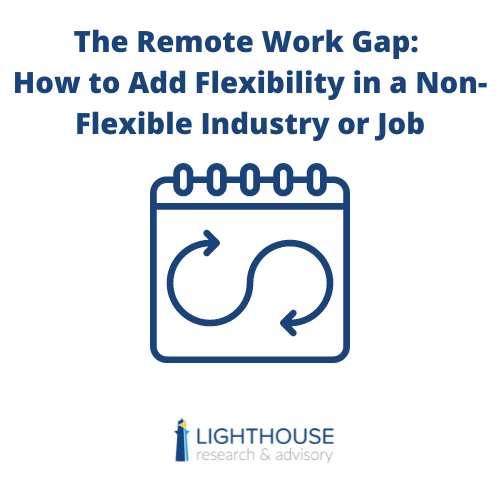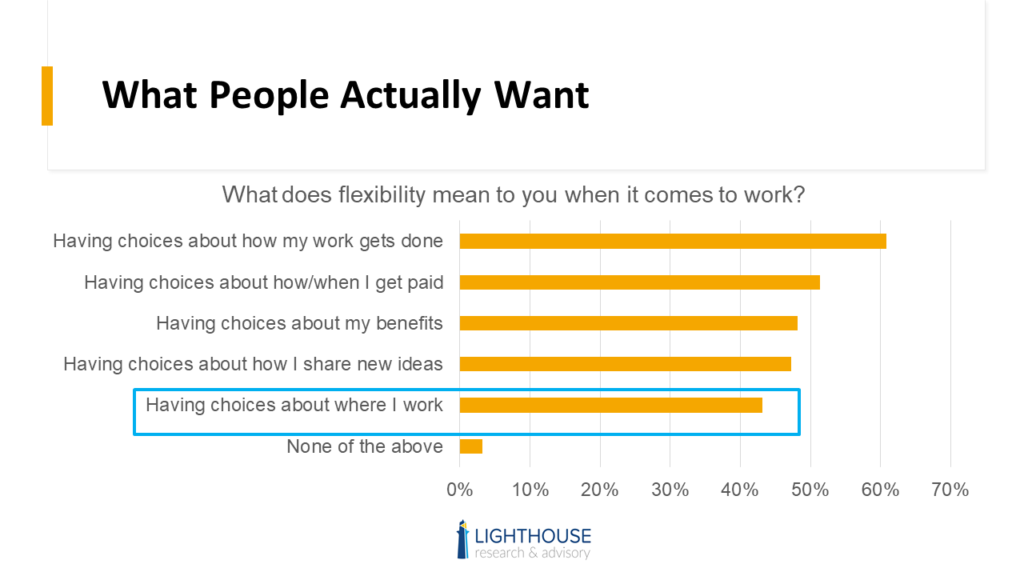The Remote Work Gap: How to Add Flexibility in a Non-Flexible Industry or Job
This is one of the hottest conversations in the workplace, today, and no, I’m not talking about the most challenging hiring environment we’ve ever seen before. I’m talking about remote work.
 If you work for a software company, chances are you’re one of many people who is working a remote or hybrid schedule these days. But if you’re in some other industries, you’re likely feeling some different emotions because you may not have the option of working virtually. While it’s easy to get caught up in the discussion of the companies in the headlines, the truth is many employers (and their workers) don’t have the option of working remotely. Their work could be:
If you work for a software company, chances are you’re one of many people who is working a remote or hybrid schedule these days. But if you’re in some other industries, you’re likely feeling some different emotions because you may not have the option of working virtually. While it’s easy to get caught up in the discussion of the companies in the headlines, the truth is many employers (and their workers) don’t have the option of working remotely. Their work could be:
- A product created in a physical environment
- A product delivered in a customer-facing environment
- A service delivered in a customer-facing environment
Still not sure what that encompasses? Consider this list:
- Manufacturing
- Construction
- Agriculture
- Mining/Oil/Gas
- Retail
- Food service
- Healthcare
- Utilities
- Public service
- Leisure, hospitality, and travel
- Trucking and logistics
These industries employ millions of workers that do not have the option of connecting in and doing their job from a home office. And for more than a year, the conversation/debate has raged around this. In virtually every one of the dozens of speaking events I’ve participated in over the last year, the moment remote work comes up, the audience divides into the “haves” and “have nots.”
Today, I’m going to walk through what these jobs that are not remote-friendly can do to support flexibility at work.
Oh, and by the way, when I said above that this discussion isn’t about hiring, that wasn’t exactly true. I spoke with the Chief Learning Officer for a healthcare organization recently and he explained that his company has lost dozens of highly talented applicants during the hiring process within minutes of explaining that the job isn’t a remote one. So while we’d like to segment this off as a different conversation, it’s definitely linked.
4 Ways to Rethink Flexibility
The first thing that we assume as employers is that flexibility means working from the couch in a pair of pajamas.
Stop assuming.
We want to think that flexibility is only about remote or in person or hybrid, because that’s what we keep hearing. But it’s not. It’s about someone’s control and autonomy.

I always advise employers to ask their people what flexibility means to them, because we may have a skewed vision of what that means as business leaders. Or we may think that it’s something much more robust and specific than it needs to be. Do not define flexibility for them, instead, let them do it for you.
That said, flexibility has a variety of facets. Even if we have to have people working on site because it is a business requirement, we can still offer flexibility in a few critical ways.
1) Control and autonomy options
Give them more control over how their work gets done. Don’t lower the bar on what you expect, but do lower your expectations that you can tell them exactly how to do it. While some work follows a very specific, required process, many times it does not.
For example, years ago U.S. Cellular was revitalizing its culture and one of the key aspects was increased autonomy and empowerment for front line support staff. No longer did they need to get three approvals to replace someone’s broken phone. They could just make it right, right there on the spot. Not only did it increase customer satisfaction, but it also increased workforce satisfaction as well.
This is perhaps the most important of all the options, because at its core, flexibility for any job is about choice. In those jobs that are remote-friendly, it’s about a choice of where to work. But that choice isn’t offered for these types of jobs. So the alternative is to offer them a choice of flexibility in how their work gets done to the degree it’s possible within the confines of the business operations.
2) Time off and scheduling options
Offering more granular time off or more flexibility in scheduling. In many organizations shifts are determined by managers and employees have little say in what shift they get. They may also not be allowed to swap shifts without jumping through hoops to make it happen.
The more flexible choice? Allow people to swap shifts. Put the power in their hands. Not only does this give them a bit more control over their work, but it also can take some of the stress off of managers to find workers at the last minute.
On a related note when it comes to time, consider more granular time flexibility options. A friend works for a local manufacturing firm, and if he needs to see a doctor sometime during the work day, he gets a sort of warning for taking time off. The sense he gets as an employee is that he should have just taken off a whole day to avoid that unpleasant experience. A better practice would be to allow him (or any employee) to use portions of their paid time balance as needed during the day. That could be just an hour if that kind of personal errand was near the workplace.
One of the biggest reasons people don’t use time off is because they aren’t sure how they are going to be perceived by the business leadership. In fact, when employers move to unlimited PTO, some sources say that employees use less time off than they did before because that pressure only increases.
3) Progress and mobility options
A big theme in this piece is giving up control. Have you noticed? To continue that conversation, let’s give some control to the people over their career progress and growth opportunities.
In our last research on Performance, Engagement, and Business Impact, we found that one of the top practices of companies with better revenue, employee retention, and employee engagement scores was weaving growth and development into the performance/talent management process. We’re currently in the process of updating this research, and I fully expect to see an even stronger correlation than the last time we measured.
Our data show that for every employee that is ambivalent about their career growth, there are two employees that crave and desire it. In the long run, what do you think an employee is going to appreciate more: an opportunity to work in a home office for a period of time or an opportunity to leverage their strengths, step into a dream career, and show off the capabilities they have?
4) Communication and clarity options
In the book the Idea Driven Organization, the authors talk much about the importance of listening to your people, because innovation primarily comes from those closest to the delivery of the product or service. We want to think that innovation comes from a board room or a remote executive office, but that’s uncommon. Most often it comes from the people on the front lines that see a way to improve customer satisfaction by 5% or speed up a process by 10%. Those small increments drive big value over time.
Beyond the innovation component, simply being open and clear with the workforce can work wonders. We surveyed 1,000 employees in our Reskilling, Mobility, and Talent Development study this year. We found that six out of 10 of them say they do not get any guidance from their leaders on what skills are most important to develop for long-term career success.
Be clear. Communicate often. Just because you can’t offer someone the option to work from another location doesn’t mean you need to shy away from communicating with them overall. Sharing information and requesting input creates a powerful dialogue based on trust and transparency. This is an enabler of some of the policies and approaches outlined in the other flexibility suggestions above.
ROWE: Focusing on Results for 10+ Years and Counting
The concept of a ROWE is pretty straightforward. ROWE stands for “results only work environment,” where the focus is on setting clear expectations for jobs and then holding people to those performance expectations without getting into the weeds of where, how, or when they perform. While some ROWE-related jobs are remote-friendly, the concept is highly valid and has been proven in a variety of companies over the years. Last year I interviewed one of the founders of the ROWE movement when I saw companies moving remote/virtual because I knew it would help to create clarity for leaders that had never had employees they couldn’t see working remotely.
In the end flexibility is about holding someone accountable for their results, but it’s not about holding them accountable for where they sit. And some jobs, that’s simply not possible because the work has to be delivered where the customer is. Retail, food service, hospitality, healthcare, manufacturing, and a host of other use cases require physical proximity.
But a radical idea within those realms is to empower, trust, and support someone’s decision making. While I’ve laid out some of these ideas within the context of this article and they may be new to you, I share this ROWE story because it’s been going on for over 10 years with tremendous success.
Opening the Door on Flexibility
I’ve had a version of this conversation with a variety of HR, talent, learning, and operations executives in the last year as companies struggled with the remote/in person/hybrid question, and I wanted to share it with you and a broader audience because with the current hiring market, the challenges in keeping good staff, and other factors, it’s finally time to shake some of these things up.
Do some of these ideas require a different approach or different thinking? Absolutely. But increasingly I’m hearing from leaders in these industries saying they are the hardest hit by turnover, disengaged employees, and the like. And it has to stop.
One half of our research here at Lighthouse looks at the trends and competitive practices of innovative employers, and you’ve seen some of that data cited here. But the other half is focused on the technologies and tools that enable us to hire, support, engage, and retain the workforce from an employer perspective. If you ever want to know more about the technologies that exist to solve very specific problems with talent or business, please don’t hesitate to reach out.
At the end of the day, flexibility is, well, flexible. It doesn’t have to just mean where. It can mean when, or how, or what. Let’s talk with our people, find out what flexibility truly means to them, and work to deliver that in a meaningful way.

Ben Eubanks is the Chief Research Officer at Lighthouse Research & Advisory. He is an author, speaker, and researcher with a passion for telling stories and making complex topics easy to understand.
His latest book Talent Scarcity answers the question every business leader has asked in recent years: “Where are all the people, and how do we get them back to work?” It shares practical and strategic recruiting and retention ideas and case studies for every employer.
His first book, Artificial Intelligence for HR, is the world’s most-cited resource on AI applications for hiring, development, and employee experience.
Ben has more than 10 years of experience both as an HR/recruiting executive as well as a researcher on workplace topics. His work is practical, relevant, and valued by practitioners from F100 firms to SMB organizations across the globe.
He has spoken to tens of thousands of HR professionals across the globe and enjoys sharing about technology, talent practices, and more. His speaking credits include the SHRM Annual Conference, Seminarium International, PeopleMatters Dubai and India, and over 100 other notable events.
